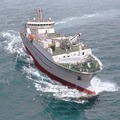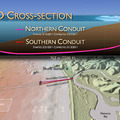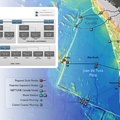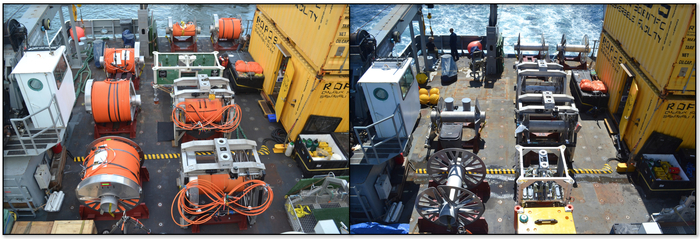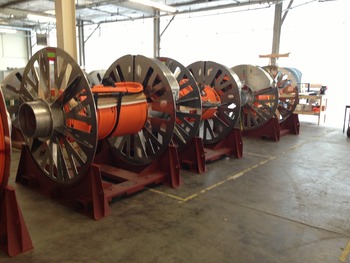
Over 22 km of extension cables were deployed by the robotic vehicle ROPOS during the VISIONS'13 expedition.The cables were spooled onto drums and installed using the Remotely Operated Cable Laying System (ROCLS) latched beneath ROPOS.
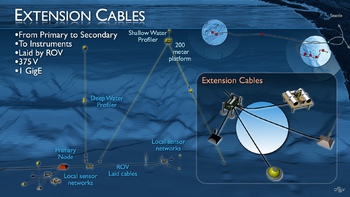
Extension cables will connect the primary nodes to secondary nodes and then to myriad instruments and sensors. Over 22,000 m of extension cables were deployed with the remotely operated vehicle ROPOS during the VISIONS'13 expedition, July - August, 2013.
Primary or Backbone Cable
The OOI Cabled Array builds on telecom industry sub-sea cable to provide power (10 kV DC, up to 8 A) and communications (10 Gb/s) via fiber-optics and copper between the Primary Nodes and the Shore Station. The backbone cable was installed Summer 2011 using the commercial cable laying ship, the TE SubCom Dependable and was designed for at least a 25 year life expectancy.
Approximately 900 km of primary cables were installed from the Shore Station in Pacific City, Oregon to the seven Primary Node locations. These sites include PN1A at the base of the subduction zone west of Newport Oregon, PN1B at Southern Hydrate Ridge, PN1C at a 600 m site on the Newport margin, PN5A in the middle of the Juan de Fuca plate, PN3A at the base of Axial Seamount, and PN3B at the summit of the volcano. The primary nodes were installed in summer 2012. A major function of the Primary Nodes is to pass power and bandwidth on to nodes further offshore, e.g. Primary Node 5 sends power and bandwidth on to Primary Node 3A. One line of the backbone/primary cable connects the Cabled Array to the shared Endruance Array. Extension cables to Low-Voltage and Medium-Voltage junction boxes are part of the Secondary Infrastructure, providing power and bandwidth to myriad sensors and instrumented full water-column moorings operational since 2014.
Extension Cables
Over 33,000 m of extension cables are now installed on the seafloor at lengths up to ~ 5 km. They were installed using the remotely operated vehicle ROPOS with the ROCLS system (remotely operated cable laying system) attached to its underbelly. All cables have functioned perfectly since their installation.
The Extension Cables provide power and communication links between the Primary Infrastructure, Secondary Infrastructure, and instruments. Extension Cables link Primary Nodes to LV Nodes to J-Boxes, and to instruments across the Cabled Array. The cables were installed in a variety of environments, including the summit of Axial Seamount. The cables power different types of loads, requiring the installation of different types of cables. Primary Nodes are set at depths down to ~3000 m and extension cables link to elements along the seafloor and from the seafloor to near the surface. All extension cables have been documented in terms of their power/communications requirements and in consideration of special environmental requirements. This includes various levels of armoring for deployments in volcanic areas such as the flanks and caldera of Axial Seamount. These are included in the block diagrams and budgeted appropriately.
Two fundamental characteristics of the Cabled Array include the ability to expand the coverage area and number of sensors, and the ability to operate for over 25 years. To support this, ROV wet-mate connectors are used in many of the extension cable assemblies to allow for additional cables to be added to the system and for existing components to be temporarily removed from the system for maintenance.

